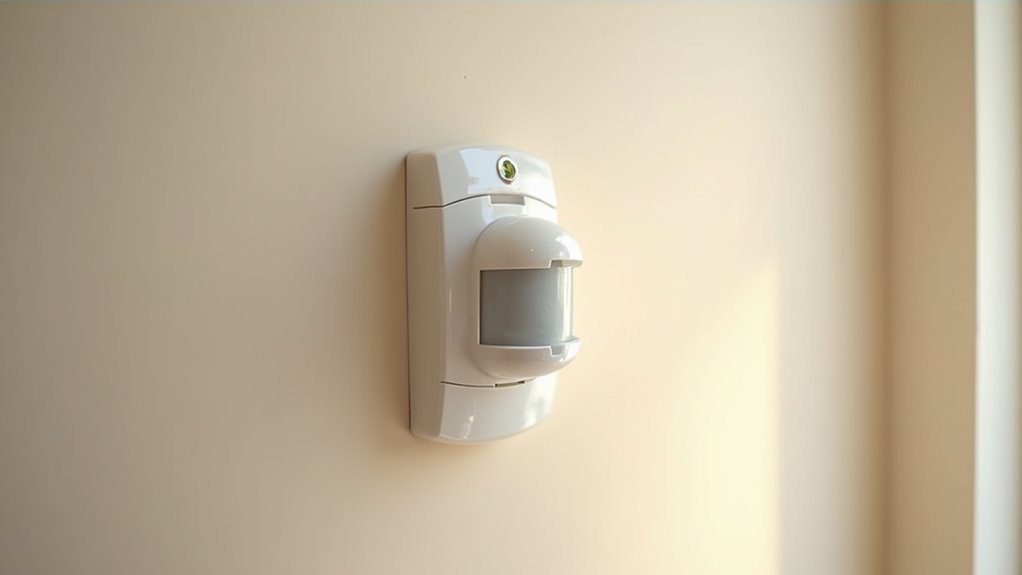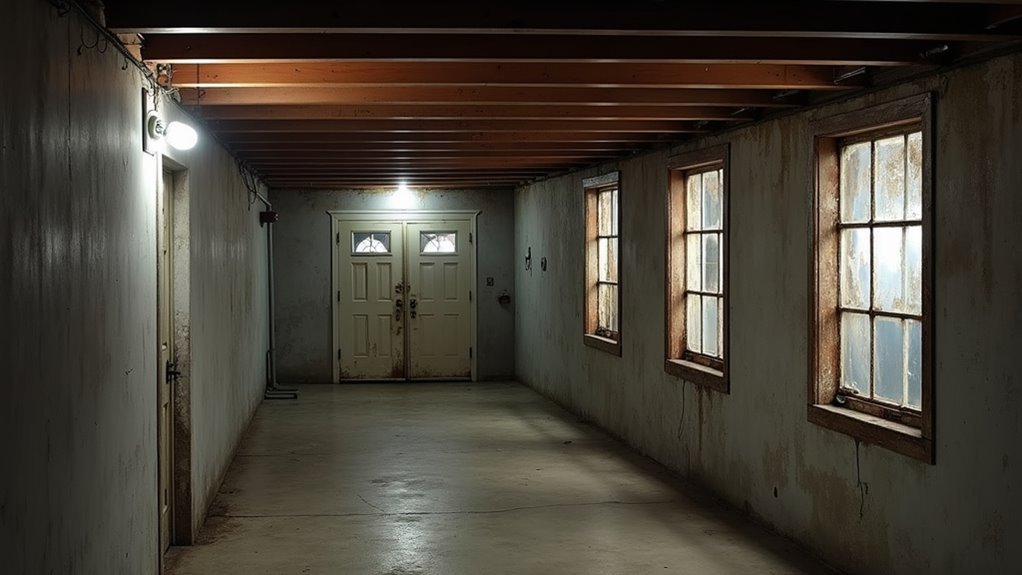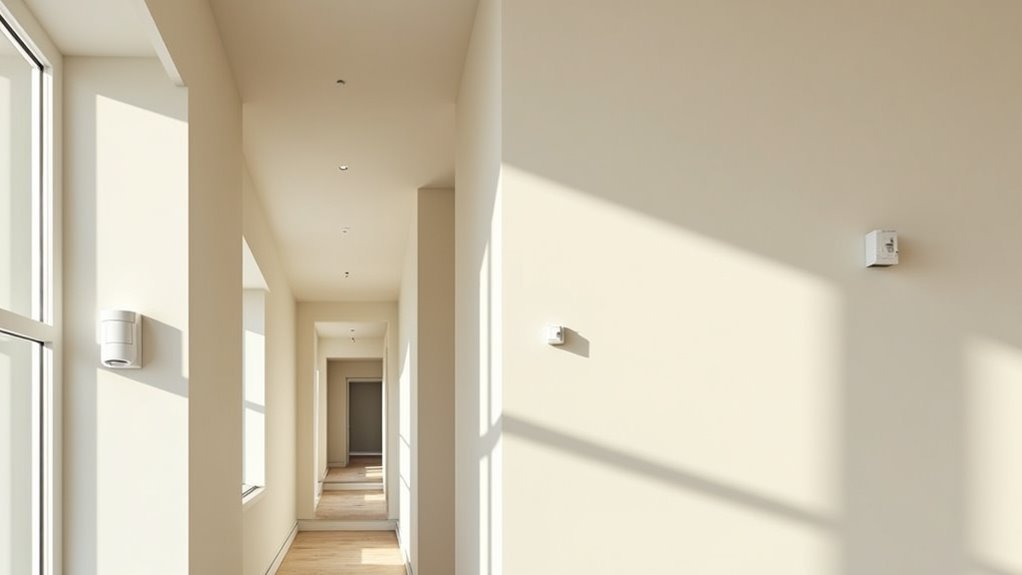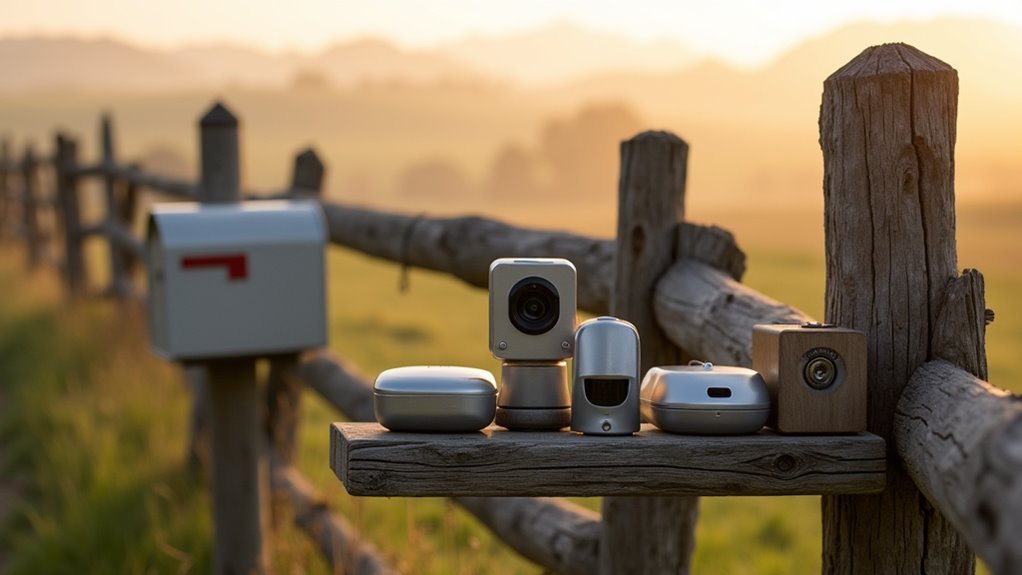You’ve invested in motion sensors, but their effectiveness depends entirely on where you place them. Position them incorrectly, and you’ll create dangerous blind spots that intruders can exploit. Mount them too high or too low, and they won’t detect movement properly. Choose the wrong angles, and you’ll miss critical side-to-side motion that could signal a break-in. The difference between ideal and poor sensor placement could determine whether your security system protects your home or fails when you need it most.
High-Traffic Areas Maximize Detection Coverage

When you’re deciding where to position motion sensors in your home, targeting high-traffic areas should be your first priority.
These strategic locations maximize your security effectiveness by ensuring sensors detect movement from intruders who’ll most likely pass through these natural pathways.
High-traffic areas like hallways and entry points provide broader coverage, capturing movement from multiple angles as potential threats enter your home.
Corner Placement Provides Widest Room View
When you position motion sensors in corners, you’ll achieve the maximum coverage area possible within any room.
Corner placement creates an ideal vantage point that allows your sensor’s detection field to fan out across the widest possible range.
You’ll also enhance your system’s ability to detect side-to-side motion, which proves far more effective than relying on straight-on detection patterns.
Maximum Coverage Area
Since motion sensors work best when they can detect movement across the widest possible area, corner placement offers the most strategic advantage for your security system.
You’ll achieve maximum coverage by positioning sensors where they can monitor the entire room from a single vantage point.
Corner-mounted motion sensors provide superior detection capabilities through:
- Enhanced detection angle – corners allow sensors to sweep across wider areas than wall-mounted alternatives
- Reduced blind spots – furniture and obstacles rarely obstruct corner positions
- Earlier intrusion alerts – you’ll detect movement before intruders reach the room’s center
- Optimal side-to-side monitoring – captures lateral movement more effectively than forward-facing sensors
Install your sensors at 6-8 feet height in corners to guarantee clear sight lines across rooms, maximizing your security system’s effectiveness.
Side-to-Side Motion Detection
Motion sensors positioned in corners excel at detecting side-to-side movement because they’re naturally aligned with how intruders typically enter rooms.
When you place sensors in corners, you’re maximizing their ability to capture the lateral motion that occurs as someone moves through doorways or along walls. This strategic positioning takes full advantage of your sensor design, allowing the detection range to fan out across the widest possible area.
Corner placement guarantees your motion sensors can monitor multiple entry points simultaneously while maintaining peak sensitivity to side-to-side motion.
You’ll also reduce false alarms since the sensors are positioned away from typical pet traffic patterns. This configuration provides superior room coverage compared to wall-mounted sensors, making corners the ideal location for extensive security monitoring.
Six to Eight Feet Height Offers Optimal Detection Range

Although sensor placement might seem straightforward, you’ll achieve peak detection by mounting your motion sensors at six to eight feet above the floor. This positioning creates the ideal detection range for your home security system while maximizing passive infrared sensor effectiveness.
Mount motion sensors at six to eight feet above floor level for optimal detection range and maximum passive infrared sensor effectiveness.
Here’s why this height delivers maximum effectiveness:
- Wide Coverage: You’ll capture motion across entire rooms and entrances without blind spots.
- Pet Interference Reduction: Small animals won’t trigger false alarms from ground-level movement.
- Obstruction Avoidance: Furniture and decor won’t block your sensor’s line of sight.
- Heat Detection Accuracy: The sensor reads body heat without interference from floor temperature changes.
This six to eight feet mounting height aligns perfectly with passive infrared technology, ensuring your motion sensors operate within their most sensitive detection zone.
Entry Points Create First Line of Defense
While determining the ideal height for your motion sensors establishes proper detection range, strategic placement at entry points transforms your security system into a formidable first line of defense.
You’ll want to position sensors near front and back doors since they’re the most common access points for intruders. This placement guarantees immediate alerts upon unauthorized access, giving you vital early warning.
Research shows over 30% of burglaries occur through unlatched doors or windows, making vigilant monitoring essential.
When you discretely install motion sensors at these locations, you’ll surprise potential intruders and deter break-ins before they happen.
Basement Locations Monitor Vulnerable Access Points

Beyond securing main entry points, basements present unique vulnerabilities that demand strategic motion sensor placement.
You’ll find that basements often serve as vulnerable access points where intruders can enter undetected through basement windows or doors that aren’t visible from your main living areas.
Installing motion sensors in your basement helps you monitor unauthorized access while protecting valuable items like tools and equipment stored below.
Here’s how to maximize basement security:
- Position sensors in corners for wide-field coverage
- Monitor less visible windows and doors
- Detect movement around valuable storage areas
- Alert you to subtle intrusion attempts
Your basement motion sensors create an essential security layer, ensuring that even the most discreet entry attempts won’t go unnoticed in these typically overlooked spaces.
Behind Valuables Adds Extra Protection Layer
You’ll create an additional security barrier by positioning motion sensors directly behind your most valuable items like electronics, jewelry, and artwork.
This strategic placement guarantees that any unauthorized movement near these high-priority assets triggers an immediate alert, giving you real-time notification of potential theft attempts.
The sensors act as a focused detection system that complements your broader security coverage while specifically protecting your most important possessions.
Strategic Placement Near Assets
The most effective motion sensor placement involves positioning devices directly behind your most valuable possessions. This strategic placement creates an additional layer of security that’ll alert homeowners the moment someone approaches these critical areas.
You’ll want to protect your home by focusing on locations where valuable items are stored or displayed.
Consider these key positioning strategies:
- Behind safes and filing cabinets – Detect unauthorized access attempts to secure storage areas
- Near expensive electronics – Monitor televisions, computers, and gaming systems that thieves commonly target
- Around jewelry displays – Cover areas where precious items are kept or showcased
- By art collections – Protect valuable artwork and collectibles from potential theft
Motion sensors positioned near these assets trigger immediate alarms and notifications, providing thorough coverage when you’re away.
Immediate Alert Triggering
When intruders bypass your perimeter defenses, motion sensors positioned behind valuables become your final line of defense, triggering instant alerts the moment someone reaches your most precious items. This strategic placement guarantees unauthorized access to your valuable items generates an immediate alert, dramatically reducing response times when seconds matter most.
Your motion sensors create a focused detection zone that catches thieves in the act before they can escape with your belongings. This targeted approach allows your security system to enhance security by monitoring specific high-value areas rather than relying solely on general room coverage.
| Detection Zone | Response Time | Alert Type | Coverage Area | Deterrent Effect |
|---|---|---|---|---|
| Behind safes | 0.5 seconds | Instant push notification | 10-foot radius | High visibility deters attempts |
| Near jewelry boxes | 0.3 seconds | SMS + app alert | 8-foot radius | Psychological deterrent factor |
| Behind artwork | 0.4 seconds | Email notification | 12-foot radius | Professional installation recommended |
| Under electronics | 0.6 seconds | Phone call alert | 6-foot radius | Hidden placement advantage |
| Near documents | 0.2 seconds | Multi-channel alert | 5-foot radius | Compact sensor options |
Hallways and Staircases Capture Movement Patterns
Since intruders typically use hallways and staircases as primary pathways when moving between rooms, these areas become essential locations for motion sensor placement.
You’ll maximize your security effectiveness by positioning motion sensors where they can monitor multiple entry points simultaneously.
Hallways and staircases offer strategic advantages for detecting motion:
Strategic corridor placement transforms your motion detection system into a comprehensive security network that captures movement across multiple access points.
- Enhanced coverage – You’ll monitor several access routes with fewer sensors
- Side-to-side detection – Motion sensors capture lateral movement more effectively in these narrow spaces
- Early warning system – You’ll detect intruders before they reach more secure areas
- Optimal positioning – Installing sensors 6-8 feet high eliminates blind spots
These high-traffic corridors guarantee your motion sensors won’t miss unauthorized movement, providing thorough protection throughout your property.
Near Bedrooms Protects Sleeping Areas
You’ll want to position motion sensors strategically near your bedrooms to create an early warning system that alerts you before any intruder reaches your sleeping areas.
Focus on monitoring the hallway access points that lead to your bedrooms, as these corridors serve as natural chokepoints where unauthorized movement can be detected.
This placement guarantees you’re notified of potential threats while you’re most vulnerable during sleep, giving you precious time to respond appropriately.
Alert Before Intruder Entry
Although intruders often target homes during nighttime hours when occupants are asleep and most vulnerable, positioning motion sensors near bedrooms creates a vital early warning system that can mean the difference between being caught off guard and having precious time to respond.
Strategic sensor placement transforms your security by:
- Creating detection barriers – Sensors in hallways leading to bedrooms alert you before unauthorized access reaches your private spaces.
- Providing immediate notifications – You’ll receive instant alerts when motion sensors detect significant movement near sleeping areas.
- Monitoring entry points – Sensors track windows and doors adjacent to bedrooms for thorough protection.
- Minimizing false alarms – Advanced programming guarantees pets won’t trigger unnecessary alerts while maintaining reliable intruder detection.
This layered approach gives you essential reaction time.
Monitor Hallway Access Points
Motion sensors positioned in hallways create the most effective choke points for detecting intruders before they reach your bedroom. These hallway access points serve as critical transit areas where you’ll catch unauthorized movement early, giving you time to respond to security breaches.
| Placement Factor | Recommendation |
|---|---|
| Height | 6-8 feet |
| Coverage Area | Full hallway width |
| Sensor Type | PIR motion detector |
| Alert Response | Immediate notification |
| Detection Range | 15-20 feet |
Optimal sensor placement at proper height minimizes false alarms while maximizing coverage. You’ll detect movement from intruders seeking bedroom access, creating an additional security layer. This strategic positioning guarantees any unauthorized activity triggers alerts before threats reach sleeping areas, providing enhanced peace of mind during vulnerable nighttime hours.
Multiple Access Points Eliminate Blind Spots
When intruders attempt to breach your home, they’ll typically target doors, windows, and other vulnerable entry points where inadequate sensor coverage creates dangerous blind spots.
Installing motion sensors at multiple access points provides extensive coverage that prevents unauthorized entry from going undetected.
Strategic placement eliminates blind spots through:
- Positioning sensors at all entryways – doors, windows, and secondary access points
- Creating overlapping detection zones that cover potential approach angles
- Integrating motion sensors with security cameras for enhanced surveillance capabilities
- Installing devices in high-traffic areas and corners to maximize field of vision
This layered approach guarantees you’ll detect movement from various directions, creating an effective security network that leaves no vulnerable areas exposed to potential intrusions.
Away From Heat Sources Prevents False Alarms
Heat sources pose one of the biggest threats to your motion sensor system’s reliability. PIR sensors detect infrared radiation, making them vulnerable to false alarms from radiators, stoves, and air vents. These heat-emitting appliances create temperature fluctuations that your sensors misinterpret as movement, triggering unnecessary alerts.
Proper placement guarantees reliable detection by maintaining distance from heat sources. You’ll want at least 10 feet between your motion sensors and any heat-emitting devices to prevent interference.
| Heat Source | Risk Level | Recommended Distance |
|---|---|---|
| Radiators | High | 10+ feet |
| Stoves | Very High | 12+ feet |
| Air Vents | Medium | 8+ feet |
| Space Heaters | High | 10+ feet |
False alarms lead to desensitization, causing you to potentially ignore legitimate threats. Strategic positioning away from heat sources maximizes your system’s accuracy.
Clear Line of Sight Ensures Proper Function
You’ll need to guarantee nothing blocks your motion sensor’s detection path to maintain reliable performance.
Place sensors at 6 to 8 feet high where they can monitor the area below without furniture, walls, or decorative items creating blind spots.
This ideal positioning maximizes your sensor’s coverage area while allowing it to accurately detect infrared radiation from moving bodies.
Obstacles Block Detection Rays
One of the most critical factors in motion sensor effectiveness is maintaining an unobstructed detection path between the device and the areas you’re monitoring.
Obstacles can considerably compromise your motion sensors’ ability to detect movement by blocking detection rays and creating dangerous blind spots.
When obstacles interfere with clear line of sight, your security system’s reliability decreases dramatically. Proper placement requires careful consideration of your field of view:
- Remove furniture blocking sensor paths
- Avoid positioning near large appliances
- Check for wall obstructions during installation
- Test detection coverage after mounting
Walls, cabinets, and other barriers prevent sensors from picking up heat signatures effectively.
Strategic placement at 6-8 feet height and corner positioning helps minimize these issues while maximizing coverage area.
Optimal Height Maximizes Coverage
Mounting your motion sensor at the correct height dramatically impacts its detection capabilities and overall security effectiveness. Installing sensors at an ideal height of 6 to 8 feet guarantees maximum coverage while maintaining clear sight lines throughout your space.
This elevated sensor placement allows you to detect movement across wider areas without obstruction from furniture or decorations that could block lower-mounted devices. Proper height positioning greatly reduces false alarms caused by pets or small animals moving below the detection zone.
You’ll achieve unobstructed detection of human-sized intruders while avoiding unnecessary triggers. The 6-to-8-foot range also enhances angle detection, enabling your sensor to capture side-to-side movement more effectively than direct approaches.
This strategic positioning eliminates blind spots that occur when sensors are mounted too low, providing extensive security coverage.
Strategic Angles Detect Side-to-Side Movement
When positioning motion sensors at strategic angles, you’ll dramatically improve their ability to detect side-to-side movement compared to sensors that face straight ahead.
These angled installations detect infrared energy changes more effectively as bodies move across their field of view.
Angled motion sensors capture infrared signatures more efficiently when detecting lateral movement patterns across their detection zones.
Here’s why strategic angles enhance your security system:
- Corner installations provide wider coverage, monitoring multiple entry directions rather than just linear pathways.
- Optimal 6-8 foot range maximizes sensor effectiveness while eliminating blind spots through proper angling.
- Earlier detection allows sensors to trigger alarms before intruders reach main entry points.
- Minimized false triggers help reduce false alarms by avoiding non-target motion like pets or passing vehicles.
Strategic positioning transforms your motion sensors into more reliable detection tools.
Indoor Vs Outdoor Sensor Considerations
Indoor and outdoor motion sensors demand different positioning strategies due to their distinct operating environments and detection requirements.
You’ll need to place indoor sensors in high-traffic areas and corners to maximize detection coverage while keeping them away from heat sources that cause false alarms. Position these sensors to detect body heat effectively without furniture obstructions blocking their view.
For outdoor sensors, focus placement on entry points like doors and driveways at 6-8 feet height.
You’ll want to avoid direct sunlight and guarantee weatherproofing for reliable operation. Outdoor sensors often combine multiple technologies to extend range and reduce false triggers from animals.
Strategic positioning should cover blind spots while maintaining clear sight lines to effectively detect potential intruders approaching your property.
Professional Monitoring Integration Benefits
While motion sensors provide excellent detection capabilities on their own, integrating them with professional monitoring services transforms your security system into a thorough protection network.
Professional monitoring enhances your motion sensors’ effectiveness through several key advantages:
- 24/7 Response Coverage – Trained personnel immediately assess alerts from your motion sensors, ensuring prompt action even when you’re unavailable.
- Automatic Emergency Services Dispatch – Critical situations trigger immediate contact with police or emergency responders, eliminating delays in your response time.
- False Alarms Reduction – Professional operators filter non-threatening alerts, preventing unnecessary stress and avoiding potential municipal fines.
- Insurance Benefits – Many homeowners insurance providers offer discounts for professionally monitored systems, recognizing their superior security effectiveness.
This integration maximizes your motion sensors’ protective value while minimizing operational headaches.
Frequently Asked Questions
Where Should Motion Sensors Be Placed?
You should place motion sensors in high-traffic areas like hallways and doorways, mount them in corners at 6-8 feet height, and avoid positioning them behind furniture or near heat sources.
Where Should Sensors Be Placed?
You should place sensors in high-traffic areas like hallways and entryways, mount them in corners at 6-8 feet height, and position them near valuable items while avoiding furniture obstructions.
How Will the Sensor Be Positioned so That It Will Work Effectively?
You’ll position sensors 6-8 feet high on walls with clear sight lines, angle them to detect side-to-side movement from doorways, and place them in corners to maximize coverage while avoiding furniture obstructions.
What Is a Motion and Position Sensor?
You’ll find motion sensors detect movement through infrared radiation from heat sources like bodies, while position sensors determine object locations using distance measurements, both enhancing your smart home’s security and automation capabilities.





Leave a Reply